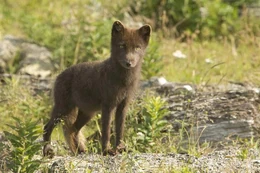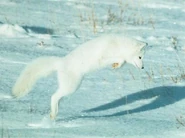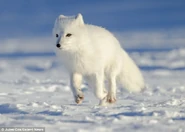
Arctic Fox (Winter Coat)
The Arctic fox (Vulpes lagopus), also known as the white fox, polar fox, or snow fox, is a small fox native to the Arctic regions of the Northern Hemisphere and common throughout the Arctic tundra biome. It is well adapted to living in cold environments. It has a deep thick fur which is brown in summer and white in winter. Its body length ranges from 46 to 68 cm (18 to 27 in), with a generally rounded body shape to minimize the escape of body heat.
The Arctic fox preys on any small creatures such as: lemmings, voles, ringed seal pups, fish, waterfowl, and seabirds. It also eats carrion, berries, seaweed, insects, and other small invertebrates. Arctic foxes form monogamous pairs during the breeding season and they stay together to raise their young in complex underground dens. Occasionally, other family members may assist in raising their young.
The arctic fox is an incredibly hardy animal that can survive frigid Arctic temperatures as low as –58°F (-50°C) in the treeless lands where it makes its home. It has furry soles, short ears, and a short muzzle—all-important adaptations to the chilly clime. Arctic foxes live in burrows, and in a blizzard they may tunnel into the snow to create shelter.
Arctic Adaptations

Arctic Fox (Summer Coat)
Arctic foxes have beautiful white (sometimes blue-gray) coats that act as very effective winter camouflage. The natural hues allow the animal to blend into the tundra's ubiquitous snow and ice. When the seasons change, the fox's coat turns as well, adopting a brown or gray appearance that provides cover among the summer tundra's rocks and plants.
These colorings help foxes to effectively hunt rodents, birds, and even fish. But in winter prey can be scarce on the ground. At such times, arctic foxes will follow the region's premier predator—a polar bear—to eat the leftover scraps from its kills. Foxes will also eat vegetables when they are available. Like a cat's, this fox's thick tail aids its balance. But for an arctic fox the tail (or "brush") is especially useful as warm cover in cold weather. Female arctic foxes give birth each spring to a large litter of up to 14 pups.
Distribution and Habitat[]
The Arctic fox has a circumpolar distribution and occurs in Arctic tundra habitats in northern Europe, northern Asia, and North America. Its range includes Greenland, Iceland, Fennoscandia, Svalbard, Jan Mayen and other islands in the Barents Sea, northern Russia, islands in the Bering Sea, Alaska, and Canada as far south as Hudson Bay. In the late 19th century, it was introduced into the Aleutian Islands southwest of Alaska. It mostly inhabits tundra and pack ice, but is also present in boreal forests in Canada and the Kenai Peninsula in Alaska. They are found at elevations up to 3,000 m (9,800 ft) above sea level and have been seen on sea ice close to the North Pole.
The Arctic fox is the only land mammal native to Iceland. It came to the isolated North Atlantic island at the end of the last ice age, walking over the frozen sea. The Arctic Fox Center in Súðavík contains an exhibition on the Arctic fox and conducts studies on the influence of tourism on the population. Its range during the last ice age was much more extensive than it is now, and fossil remains of the Arctic fox have been found over much of northern Europe and Siberia.




